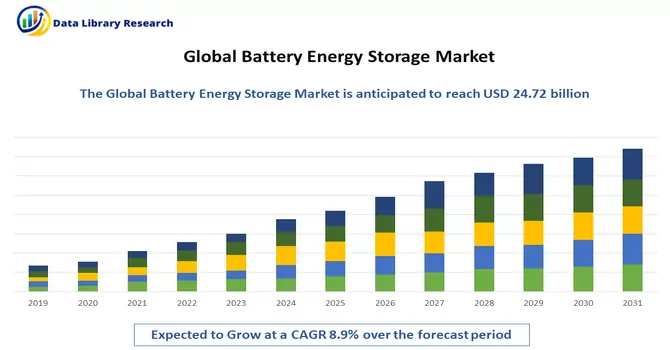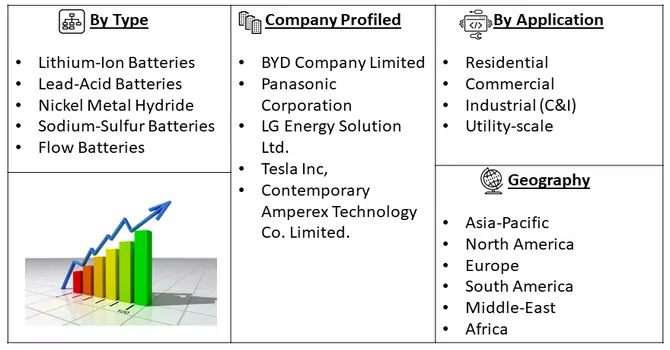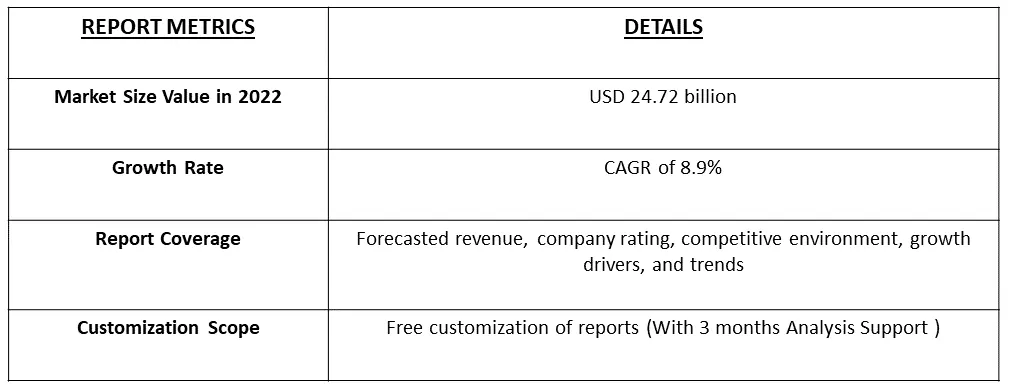The Battery Energy Storage System (BESS) market is currently valued at USD 24.72 billion in 2022 and is expected to reach USD 48.9 billion by 2030, with a compound annual growth rate (CAGR) of 8.9% during the forecast period.

Get Complete Analysis Of The Report - Download Free Sample PDF
BESS is a technology that stores energy from various sources and releases it as needed. Comprising one or more batteries, BESS is utilized to stabilize the electric grid, provide backup power, and enhance grid stability. These battery storage stations are designed to deliver their full-rated power for several hours, serving short-term peak power and ancillary services like operational reserve and frequency control to minimize the risk of power outages. Typically, they are co-located with active or decommissioned power stations to optimize grid connections and reduce costs.
Governments worldwide are pushing towards achieving net-zero carbon emissions, emphasizing advancements in renewable energy systems encompassing solar, wind, hydro, and other sustainable sources. As the need to store energy to use during non-renewable generating hours intensifies, efficient energy storage becomes paramount.
Segmentation:
The Battery Energy Storage System Market is segmented
By Type
By Application
Geography

For Detailed Market Segmentation - Download Free Sample PDF
Drivers:
Increasing Demand for Grid Energy Storage Systems:
Grid-scale energy storage systems are on the rise to provide grid operators with the flexibility required to maintain a balanced energy supply. They also contribute to grid infrastructure's resilience and robustness. The past few years have witnessed a substantial increase in large-scale energy storage system deployments. This growth is attributed to advancements in energy storage technology cost-effectiveness, distributed generation accommodation, and government incentives.
The Surge in Rural Electrification Projects Worldwide:
Global efforts have led to a significant drop in the number of people without access to electricity, creating a surge in rural electrification projects. India, in particular, has made remarkable progress, connecting millions of households to the grid through initiatives like the Saubhagya scheme. These rural electrification endeavors result in increased energy demand, further driving the BESS market.
Restraints:
High Capital Expenditure:
Integrating various components like batteries, inverters, battery management systems, and wiring escalates the cost of battery energy storage systems. The capital outlay for these systems is also influenced by factors like energy and power density requirements, components used, and facility infrastructure.
The battery energy storage system market faced significant challenges due to the COVID-19 pandemic, with global lockdowns disrupting production and manufacturing. Supply chain disruptions created gaps, and economic repercussions were felt across the industry. Key players witnessed a temporary slowdown in development and revenue generation.
The ongoing conflict between Russia and Ukraine disrupted the supply chain across borders, leading to increased prices and expected market growth in the foreseeable future.
Segmental Analysis:
Segmental Analysis By Type Lithium Batteries are Expected to Drive the Growth of the Studied Market Over the Forecast Period.
A lithium-ion or Li-ion battery is a type of rechargeable battery that uses the reversible reduction of lithium ions to store energy. The development of new lithium batteries and the launch of new products are expected to drive the growth of the studied market. For instance, in August 2023, Piedmont Lithium in one of the meetings reported that North Carolina officials for starting the lithium mines that would supply the electric vehicle battery metal to Tesla. Thus, such developments are expected to drive the growth of the studied market.
By Application Residential Segment is Expected to Witness Significant Growth Over the Forecast Period.
The increasing demand for uninterrupted and reliable power supply and the rise in the adoption of solar rooftop systems by the residential sector is also expected to drive the growth of the studied segment. Further, in March 2022, the Institute for Power Electronics and Electrical Drives (ISEA) and RWTH Aachen University found that the home storage systems (HSS) accounted for 93% of the 1,357 MWh of new energy capacity installed in 2021, while the rest 7% includes industrial and large-scale storage segments. Thus, such developments are contributing to the studied market’s growth.
By Region Type Asia-Pacific Expected to Dominate the Market is Expected to Dominate the Growth of the Studied Market Over the Forecast Period.
Asia-Pacific is expected to keep leading the market for battery energy storage over the next few years. The region consists of two main types of power grids, each with different characteristics and opportunities for energy storage systems. On one side are highly developed countries like Japan, South Korea, New Zealand, and Australia, as well as other large cities with advanced grids that work well and use the latest technologies. Furthermore, the recent developments are fueling the growth of the studied market. For instance, in January 2022, Woodside Energy submitted a proposal for a 500 MW solar facility and 400 MWh of battery storage to the Western Australian Environmental Protection Authority. The facility would cover approximately 975.6 hectares within a development envelope of 1,100.3 hectares. According to the proposal, the solar facility will install approximately 1 million solar panels and support infrastructures such as a battery energy storage system and an electrical substation. Thus, such developments are fueling the growth of the studied market.

Get Complete Analysis Of The Report - Download Free Sample PDF
Competitive Landscape:
The battery energy storage system market is fragmented. Some of the major players in the market (in no particular order) are
Recent Developments:
1) In February 2023, the New York Power Authority (NYPA) and the New York State Energy Research and Development Authority (NYSERDA) introduced a battery energy storage system using high-safety, lithium-ion superCell technology for peak-shaving capabilities in NYPA's White Plains offices.
2) In October 2022, Fluence Energy GmbH and TransnetBW GmbH announced plans for the world's largest battery-based energy storage-as-transmission project, aiming to enhance energy security and support Germany's energy transition.
Q1. What is the current Battery Energy Storage Market size?
The Battery Energy Storage System (BESS) market is currently valued at USD 24.72 billion.
Q2. What is the Growth Rate of the Battery Energy Storage Market ?
Battery Energy Storage Market is expected to grow with a CAGR of 8.9% during the forecast period.
Q3. What segments are covered in the Battery Energy Storage Market Report?
By Type, By Application & Geography these segments are covered in the Battery Energy Storage Market Report.
Q4. Which region has the largest share of the Battery Energy Storage Market? What are the largest region's market size and growth rate?
Asia-Pacific region as the largest share of the market . For detailed insights on the largest region's market size and growth rate request a sample here.
Data Library Research are conducted by industry experts who offer insight on industry structure, market segmentations technology assessment and competitive landscape (CL), and penetration, as well as on emerging trends. Their analysis is based on primary interviews (~ 80%) and secondary research (~ 20%) as well as years of professional expertise in their respective industries. Adding to this, by analysing historical trends and current market positions, our analysts predict where the market will be headed for the next five years. Furthermore, the varying trends of segment & categories geographically presented are also studied and the estimated based on the primary & secondary research.
In this particular report from the supply side Data Library Research has conducted primary surveys (interviews) with the key level executives (VP, CEO’s, Marketing Director, Business Development Manager and SOFT) of the companies that active & prominent as well as the midsized organization
FIGURE 1: DLR RESEARH PROCESS

Extensive primary research was conducted to gain a deeper insight of the market and industry performance. The analysis is based on both primary and secondary research as well as years of professional expertise in the respective industries.
In addition to analysing current and historical trends, our analysts predict where the market is headed over the next five years.
It varies by segment for these categories geographically presented in the list of market tables. Speaking about this particular report we have conducted primary surveys (interviews) with the key level executives (VP, CEO’s, Marketing Director, Business Development Manager and many more) of the major players active in the market.
Secondary ResearchSecondary research was mainly used to collect and identify information useful for the extensive, technical, market-oriented, and Friend’s study of the Global Extra Neutral Alcohol. It was also used to obtain key information about major players, market classification and segmentation according to the industry trends, geographical markets, and developments related to the market and technology perspectives. For this study, analysts have gathered information from various credible sources, such as annual reports, sec filings, journals, white papers, SOFT presentations, and company web sites.
Market Size EstimationBoth, top-down and bottom-up approaches were used to estimate and validate the size of the Global market and to estimate the size of various other dependent submarkets in the overall Extra Neutral Alcohol. The key players in the market were identified through secondary research and their market contributions in the respective geographies were determined through primary and secondary research.
Forecast Model
